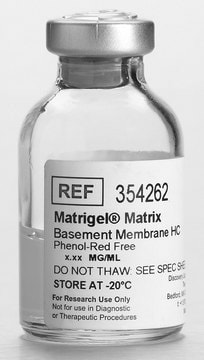E6909
ECM Gel from Engelbreth-Holm-Swarm murine sarcoma
growth-factor reduced, without phenol red, liquid, BioReagent, suitable for cell culture
Synonym(s):
GFR Basement Membrane Extract (BME)
Select a Size
Select a Size
About This Item
Recommended Products
Quality Level
product line
BioReagent
form
liquid
concentration
7-9 mg/mL
technique(s)
cell culture | mammalian: suitable
shipped in
dry ice
storage temp.
−20°C
Gene Information
mouse ... Hspg2(15530) , Lama1(16772) , Lama3(16774) , Lama5(16776) , Lamb1-1(16777) , Lamc1(226519) , Lamc2(16782) , Nid1(18073) , Sdc2(15529)
Looking for similar products? Visit Product Comparison Guide
Application
Biochem/physiol Actions
Every mouse colony used for the production of this product is routinely screened for several pathogens. Tested and found negative for LDEV
Components
The growth factor reduction modification allows for more control of medium, better interpretation of results and increased polymerization. The medium also lacks phenol red, which can interfere with some analyses.
Caution
Preparation Note
Storage Class
10 - Combustible liquids
wgk_germany
WGK 3
flash_point_f
Not applicable
flash_point_c
Not applicable
Choose from one of the most recent versions:
Certificates of Analysis (COA)
Don't see the Right Version?
If you require a particular version, you can look up a specific certificate by the Lot or Batch number.
Already Own This Product?
Find documentation for the products that you have recently purchased in the Document Library.
Articles
Cell culture protocols using ECM Gel Matrix EHS basement membrane extract (BME) for neurite outgrowth, cell invasion and angiogenesis tube formation assays.
Cell based angiogenesis assays to analyze new blood vessel formation for applications of cancer research, tissue regeneration and vascular biology.
Highlighting existing and novel fabrication methods for both, solid and hydrogel-based scaffold for tissue engineering applications.
The extracellular matrix (ECM) and its attachment factor components are discussed in this article in relation to their function in structural biology and their availability for in vitro applications.
Our team of scientists has experience in all areas of research including Life Science, Material Science, Chemical Synthesis, Chromatography, Analytical and many others.
Contact Technical Service








